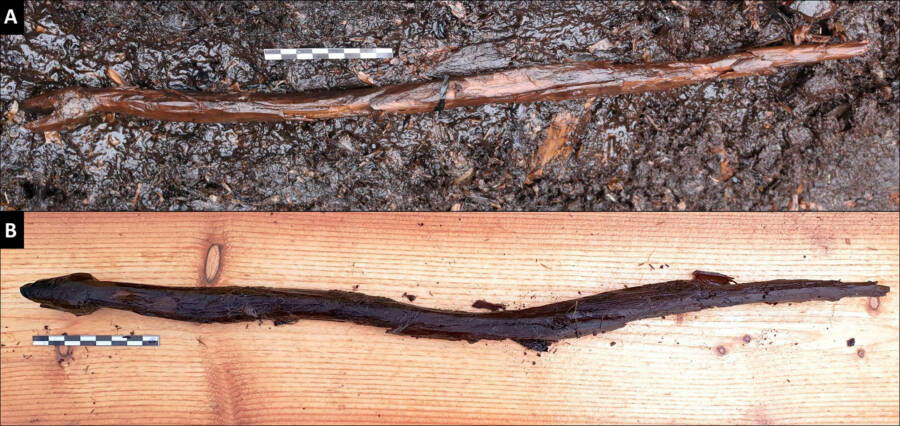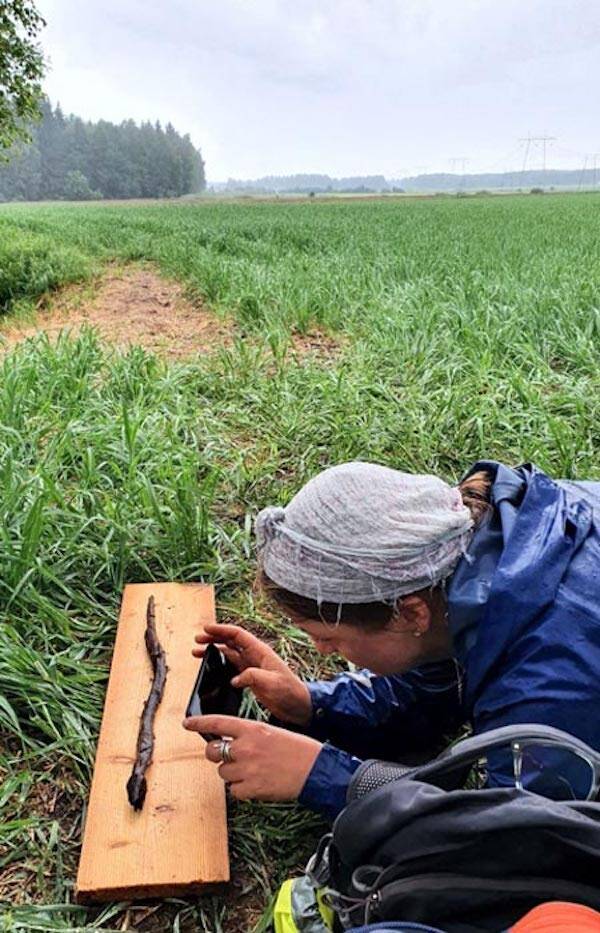The 21-inch staff was found at the Järvensuo archaeological site almost perfectly preserved — and researchers believe it was used to commune with the spirit world.

Satu KoivistoThe staff is 21 inches long and was carved from one piece of wood.
Archaeologists have just unearthed a 4,400-year-old wooden staff at a prehistoric wetland site in Järvensuo, Finland. With the site occupied by Neolithic peoples between 4,000 and 6,000 years ago and one end of the staff shaped like a snake’s head, researchers believe the item was used in rituals — by Stone Age shamans.
The staff was carved from one piece of wood and measured 21 inches, according to NBC News. Led by University of Turku archaeologist Satu Koivisto, the research team was stunned to find the relic a mere 75 miles northwest of Finland’s capital of Helsinki. Its purpose, meanwhile, appears to have been “magical.”
As published in the Antiquity journal, the subsequent study noted that nothing like this has ever been found in Finland before. Furthermore, while some Neolithic snake figurines have previously been found at similar sites across the Baltic region — none have even come close to the realistic snake depiction seen here.
“They don’t resemble a real snake, like this one,” said Koivisto. “My colleague found it in one of our trenches last summer … I thought she was joking, but when I saw the snake’s head it gave me the shivers.”

Satu KoivistoThe research team was granted three-year funding last summer.
For researchers like Koivisto, the Järvensuo archaeological site continues to be a godsend of preservation. From human remains to this staff of a slithering reptile, the marshland’s peat has worked wonders in freezing objects in time, according to Ancient Origins.
The site was accidentally found by workers in the 1950s trying to build a drainage ditch who found a wooden paddle dating to the Neolithic era. While fishing tools and pottery were found in the 1980s, a full excavation was never launched — until the Academy of Finland granted archaeologists three-year funding in 2020.
The staff itself was excavated within months of this and appears to depict either a European adder or a grass snake opening its jaws. Koivisto described the find as a “thought-provoking glimpse from far back in time,” while peripheral discoveries have made this object all the more fascinating.
Experts have long noted that North European rock art of the era in question has depicted humanoid figures holding snake staffs such as this. From Lake Onega and the White Sea in Finland’s border town of Karelia to sites in the Kola Peninsula, these rock carvings show curiously similar features to that staff unearthed here.

Satu KoivistoNothing like this has ever been found in Finland before.
Shamanic beliefs essentially purport that a litany of supernatural spirits inhabit the natural world we live in, and the research team has posited that this particular staff was used to engage in relevant rituals.
Shamans are a community’s intermediary between the world one can see and the supernatural elements hidden within. They’re arguably most comparable to the medicine men of America’s Indigenous. According to the study’s co-author, archaeologist Antti Lahelma, snakes were essential to their practice.
“There seems to be a certain connection between snakes and people,” she said. “This brings to mind northern shamanism of the historical period, where snakes had a special role as spirit-helper animals of the shaman … Even though the time gap is immense the possibility of some kind of continuity is tantalizing:”
“Do we have a Stone Age shaman’s staff?”
While the team is fairly confident this wooden relic was indeed once used as such, the “magical” rituals in question remain unidentified. The study urges readers that “great caution must be exercised in interpreting a practically unique find such as [this], particularly as the character of the site is not yet fully understood.”

Satu KoivistoThe team hopes to unearth more artifacts like this before climate change ruins their chances.
Fortunately for the experts, the item was “lost, discarded or intentionally deposited” in soil that protected it from corrosion for the last 4,400 years. While Koivisto has warned his peers that climate change will soon ruin any chance of finding more artifacts like this, some are skeptical of the find, as a whole.
“A skeptic might wonder whether the sinuous shape was deliberate, or an accidental result of four millennia of waterlogging,” said Durham University archaeologist Peter Rowley-Conwy. “I have worked on various bog sites with preserved wood, and wood fragments can be considerably distorted.”
Ultimately, it appears there’s only one surefire way to ascertain what Koivisto and Lahelma have found. Namely, combing the entire archaeological site for anything and everything trapped within its soil. While this race against time is sure to yield some more fascinating discoveries, the snake staff will have to do for now.
“I have seen many extraordinary things in my work as a wetland archaeologist, but the discovery of this figurine made me utterly speechless and gave me the shivers,” said Koivisto. “Personally I do not like living snakes, but after this discovery I have started to like them.”
After reading about the 4,400-year-old shaman staff shaped like a snake, learn about the 2,000-year-old snake altar honoring the Greek gods. Then, read about ancient traces of ayahuasca discovered in a Bolivian shaman’s pouch.





